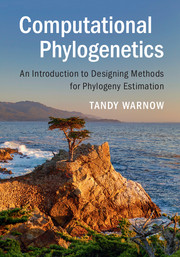Book contents
- Frontmatter
- Dedication
- Contents
- Preface
- Glossary
- Notation
- PART I BASIC TECHNIQUES
- PART II MOLECULAR PHYLOGENETICS
- 8 Statistical Gene Tree Estimation Methods
- 9 Multiple Sequence Alignment
- 10 Phylogenomics: Constructing Species Phylogenies from Multi-Locus Data
- 11 Designing Methods for Large-Scale Phylogeny Estimation
- Appendix A Primer on Biological Data and Evolution
- Appendix B Algorithm Design and Analysis
- Appendix C Guidelines forWriting Papers About Computational Methods
- Appendix D Projects
- References
- Index
10 - Phylogenomics: Constructing Species Phylogenies from Multi-Locus Data
from PART II - MOLECULAR PHYLOGENETICS
Published online by Cambridge University Press: 26 October 2017
- Frontmatter
- Dedication
- Contents
- Preface
- Glossary
- Notation
- PART I BASIC TECHNIQUES
- PART II MOLECULAR PHYLOGENETICS
- 8 Statistical Gene Tree Estimation Methods
- 9 Multiple Sequence Alignment
- 10 Phylogenomics: Constructing Species Phylogenies from Multi-Locus Data
- 11 Designing Methods for Large-Scale Phylogeny Estimation
- Appendix A Primer on Biological Data and Evolution
- Appendix B Algorithm Design and Analysis
- Appendix C Guidelines forWriting Papers About Computational Methods
- Appendix D Projects
- References
- Index
Summary
Introduction
One of the fascinating challenges in estimating the evolutionary history of a set of species is that different regions within the genomes can evolve differently due to various biological phenomena (Maddison, 1997; Mallo and Posada, 2016; Posada, 2016). One of the most obvious causes for this difference is horizontal gene transfer (Syvanen, 1985), whereby DNA is transferred from the genome of one species into that of another. Horizontal gene transfer (HGT) is especially frequent among prokaryotes (Gogarten et al., 2002), but occurs in other organisms as well. While it can be argued that a species tree is useful as a model (Mindell, 2013) and can make sense in the presence of HGT (even for prokaryotes) if it is based on genes that are resistant to HGT, a full depiction of evolutionary history when HGT has occurred requires a more general graphical model called a “phylogenetic network” (Morrison, 2014a).
Hybrid speciation, where two different species have viable offspring, is another biological process that requires a phylogenetic network. Well-known examples of hybridization include mules and hinnies (which are hybrids of horses and donkeys) and ligers and tigons (which are the hybrid offspring of lions and tigers). Hybrid speciation has long been known to be common in plants (Rieseberg, 1997), and its extent in other organisms is increasingly apparent (Pennisi, 2016). Like HGT, a proper representation of the evolutionary history of a dataset in which hybridization appears requires a phylogenetic network, rather than a tree.
There are also biological processes that cause different parts of the genomes to evolve differently, but where the species history is still correctly modeled as a tree. For example, under a gene duplication and loss model (Ohno, 1970), a gene evolves within the branches of a species tree with duplication events (that increase the number of copies of the gene within a lineage) and loss events (that reduce the number of copies of a gene), so that a given species can have multiple copies of the same gene within its genome.
Another process that can create discordance with the species tree is the multi-speciescoalescent (MSC) model (Maddison, 1997; Pamilo and Nei, 1998) (i.e., the multi-species version of the coalescent process), which models how alleles segregate into populations, and so reflects population-level processes.
- Type
- Chapter
- Information
- Computational PhylogeneticsAn Introduction to Designing Methods for Phylogeny Estimation, pp. 234 - 273Publisher: Cambridge University PressPrint publication year: 2017
- 1
- Cited by



